Kowa TSN-553 Travel Scope
Review
The travel scope from Kowa — the TSN-553
Kowa's high-end Prominar travel scope has stimulated a lot of interest. People have been asking us just how good this $1600 small scope is and how it compares to other popular travel scopes, such as the Vortex Razor or to a high-end smallish scope like the Swarovski ATX.
Their questions have inspired us to take a critical look at the new Kowa and compare it carefully side by side with some of its competitors.
First, let's meet this kitten of a scope.
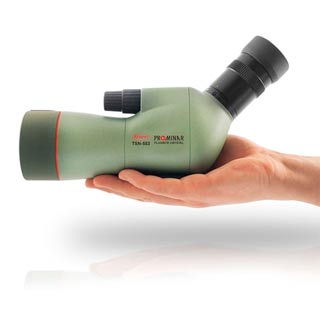
It's a kitten in the palm of your hand. It weighs only 28 ounces. Many birding binoculars weigh that much!
The 15-45x zoom eyepiece is built in to the scope. The scope comes in two styles:
- Angled (TSN-553)
- Straight (TSN-554)
The objective lens is made from natural fluorite crystal. This crystal has properties that Kowa says cannot be reproduced in glass. Finished and polished, the low-dispersion fluorite lens can transmit light with minimal chromatic aberration. As a result, color blur is eliminated, providing a sharp, high-contrast image.
In the past, Kowa has used the natural fluorite crystal only in its flagship 88mm Prominar scopes. Now Kowa is also using the fluorite crystal in the new, tiny 55mm scopes, with stunning results.
See pricing on the Kowa scope here
Comparing the Kowa and other travel scopes
In this study, we've looked at several scopes of different sizes and magnification. That's unusual for us, because normally, to compare optical quality, we study resolutions of optics at the same magnification.
But still, people ask us us, simply, how much more they can see with one scope than with another. Will a scope with higher magnification let them identify a bird at a greater distance? How much would they gain or give up by buying a more expensive or less expensive scope?
To answer those question, we mounted five scopes, each on a heavy tripod, resting on a stable, stone floor. Under controlled lighting we looked at a standard resolution chart with each scope. We zoomed the scopes' magnification up to maximum power and recorded what was the finest level of detail that we could see.
We mapped the scores on a scale of 10 to 5. The highest score was 10, representing the resolution of the high-end Swarovski at 60x. The lowest score was 5, representing the resolution of the Celestron Hummingbird at 22x. So the resolution scores show where each scope lies along the scale from the Swarovski to the Celestron Hummingbird.
Swarovski ATX
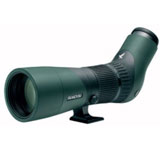
Of course the Swarovski came out with the top score. It's $3400 worth of optics, and it magnifies up to 60 power. It ought to be better than scopes costing half as much, or even less than a tenth as much. It has the best optical quality of the bunch, and it has other neat qualities as well.
For example, you can expand your Swarovski system by adding an 85 mm or 95 mm objective module. (See review of the Swarovksi ATX system.) You can also expand it by adding a 1.7x magnifier or the BTX Modular Ocular, which replaces the eyepiece and lets you view the image using both eyes.
The Swarovski is heavier and larger than the other scopes, but its superb optical quality and its ability to expand makes it a great choice if you have the money. The Swarovski is not really comparable to the other scopes in this review, which all have a smaller objective lens. However, it's included as a point of reference. We wanted to have something to mark the top of the scale.
More about the Swarovski ATX system
Kowa TSN-553
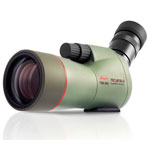
Even though the Kowa maxes out at 45 power, it delivers a great image, thanks to its natural fluorite crystal objective lens and its superb Kowa optics. It's half the price of the Swarovski — and half the weight. It came the closest to the Swarovski in resolution. It beat out the Vortex Razor 11-33x50, which is also a very good scope.
This was clearly the finest 50-to-55 mm scope in our test. For the best optics in a scope that weighs under two pounds, this is our first choice.
See pricing on the Kowa scope here
Vortex Razor 11-33x50
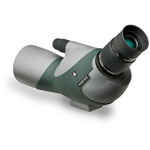
We compared the little Vortex Razor side by side with the Kowa and recorded what we could see on a resolution chart. We also compared how the scopes performed ergonomically.
When we turned both zooms to their maximum magnification, we found that that Vortex Razor provides a very nice, usable image, but it does not quite measure up to the Kowa optically. That is to be expected, since the Vortex goes up to only 33 power, while the Kowa has a top magnification of 45 power. However, the Vortex costs $1000 less! If the Kowa's price of $1679 is more than you're prepared to spend on a scope, then at $649, the Vortex Razor looks pretty good.
Ergonomically, we actually liked the Vortex Razor a little better than the Kowa. We thought the Vortex had better feel to the armoring than the Kowa. And at just 25 ounces, the Vortex weighs 3-1/2 ounces less than the Kowa. Furthermore, the Vortex has a lifetime no-fault warranty that covers accidental damage as well as manufacturer's defects, while the Kowa has a lifetime warranty only against manufacturer's defects. So we feel that a person could live a happy life with a Vortex Razor 50mm scope.
Hands-on Review review of the Vortex Razor scope
Nikon 50 mm Fieldscope

This Nikon Fieldscope is small scope that has been around for many years, and which is about the same price as the 50mm Vortex Razor. The Nikon's maximum magnification is 30x, which is a bit less than the Vortex and only 2/3 of that of the Kowa. So it was not a suprise that the Nikon did not measure up to the Vortex or the Kowa.
The Nikon has the disadvantage of an eye relief of only 12.9 mm, which not adequate for most wearers of glasses. The eyecup is the old-fashioned roll-down rubber style. The one advantage of the Nikon over the other scopes is the Nikon's compactness. It weighs only 20.1 ounces, compared to 25 ounces for the Vortex and 28.6 ounces for the Kowa.
Celestron Hummingbird
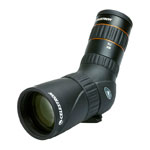
We included the diminutive Celestron Hummingbird in our study so that we could see how well such a such a tiny, inexpensive scope could perform.
Because it will actually fit in a cargo pocket, it fills a niche. It maxes out at 22 power, which will let you see stuff that your 8- or 10-power binocular won't. Many birders often use their full-sized scopes at 20 power.
At 19 ounces it weighs less a 42mm binocular. Indeed, because it zooms down to 7 power, you can hand hold it. It will actually slip into a cargo pocket, and you're likely to take it along when you wouldn't carry a bigger scope.
This little scope anchors the lower end of the scale for our resolution test. Even though it's last in the test, it has ED glass, and it still gives a pretty good image. Better than many scopes in its price range. We like it a lot.

